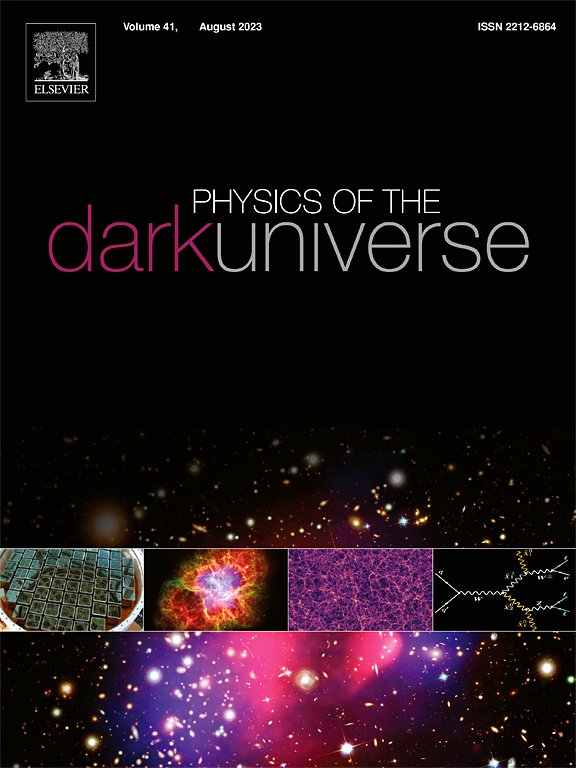概述当前数据可以(和还不能)说明的暗能量演变
IF 5
2区 物理与天体物理
Q1 ASTRONOMY & ASTROPHYSICS
引用次数: 0
摘要
最近对Ia型超新星的重子声学振荡(BAO)和距离模量的测量表明,以时变状态方程(EoS)为特征的动态暗能量(DDE)场景更受青睐。本综述通过独立测量和调查评估其稳健性。利用Chevallier-Polarski-Linder (CPL)参数化来描述DE EoS的演化,我们分析了超过35个数据集组合,包括普朗克宇宙微波背景(CMB)各向异性,三个独立的Ia型超新星(SN)目录(PantheonPlus, Union3, DESY5),来自DESI和SDSS的BAO测量,以及从宇宙早期被动演化的大质量星系的相对年龄推断的膨胀率测量H(z)。本综述有两个主要目标:首先,评估DDE偏好在不同数据集组合中的统计显著性,这些数据集组合包含不同的信息来源。具体来说,我们考虑了仅以不同组合使用低红移探测器的情况,以及将单个低红移探测器与CMB数据一起分析的情况,最后,在所有可能的独立组合中包含高红移和低红移探测器的情况。其次,我们提供了一个读者友好的综合,最新的宇宙学和天体物理学探测器可以(和还不能)揭示DDE。总的来说,我们的研究结果表明,同时包含PantheonPlus SN和SDSS BAO的组合显著削弱了对DDE的偏好。然而,支持DDE的有趣线索出现在不包括DESI-BAO测量的组合中:SDSS-BAO与来自Union3和DESY5的SN(有或没有CMB)的组合支持对DDE的偏好。本文章由计算机程序翻译,如有差异,请以英文原文为准。
An overview of what current data can (and cannot yet) say about evolving dark energy
Recent measurements of Baryon Acoustic Oscillations (BAO) and distance moduli from Type Ia supernovae suggest a preference for Dynamical Dark Energy (DDE) scenarios characterized by a time-varying equation of state (EoS). This focused review assesses its robustness across independent measurements and surveys. Using the Chevallier-Polarski-Linder (CPL) parametrization to describe the evolution of the DE EoS, we analyze over 35 dataset combinations, incorporating Planck Cosmic Microwave Background (CMB) anisotropies, three independent Type Ia supernova (SN) catalogs (PantheonPlus, Union3, DESY5), BAO measurements from DESI and SDSS, and expansion rate measurements inferred from the relative ages of massive, passively evolving galaxies at early cosmic times known as Cosmic Chronometers (CC). This review has two main objectives: first, to evaluate the statistical significance of the DDE preference across different dataset combinations, which incorporate varying sources of information. Specifically, we consider cases where only low-redshift probes are used in different combinations, others where individual low-redshift probes are analyzed together with CMB data, and finally, scenarios where high- and low-redshift probes are included in all possible independent combinations. Second, we provide a reader-friendly synthesis of what the latest cosmological and astrophysical probes can (and cannot yet) reveal about DDE. Overall, our findings highlight that combinations that simultaneously include PantheonPlus SN and SDSS BAO significantly weaken the preference for DDE. However, intriguing hints supporting DDE emerge in combinations that do not include DESI-BAO measurements: SDSS-BAO combined with SN from Union3 and DESY5 (with and without CMB) support the preference for DDE.
求助全文
通过发布文献求助,成功后即可免费获取论文全文。
去求助
来源期刊

Physics of the Dark Universe
ASTRONOMY & ASTROPHYSICS-
CiteScore
9.60
自引率
7.30%
发文量
118
审稿时长
61 days
期刊介绍:
Physics of the Dark Universe is an innovative online-only journal that offers rapid publication of peer-reviewed, original research articles considered of high scientific impact.
The journal is focused on the understanding of Dark Matter, Dark Energy, Early Universe, gravitational waves and neutrinos, covering all theoretical, experimental and phenomenological aspects.
 求助内容:
求助内容: 应助结果提醒方式:
应助结果提醒方式:


